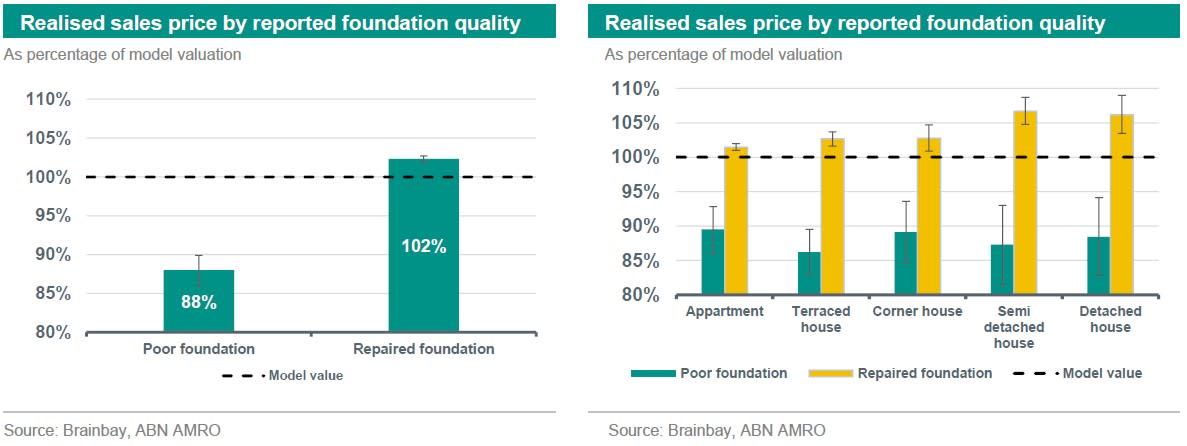SustainaWeekly - Does knowledge of foundation problems impact house prices?

In this edition of the SustainaWeekly, we first present a study the extent to which reported foundation damage is factored into the sale price of homes in the Netherlands. Climate change can increase the risk of foundation problems and is a key physical risk for housing markets. We go on to take a closer look at carbon offset markets and recent reports suggesting that carbon reduction in the underlying projects is being overstated. Furthermore we look into the consequences of the government scaling down the net-metering scheme, which has provided such a boost to small-scale solar energy generation.
Economist: Climate change can increase the risk of foundation problems.Most house sale advertisements in the Netherlands do not mention the condition of the foundation, even though it has a big effect on the house price. We estimate that the mentioning of a repaired foundation leads the house price to increase by two per cent. Meanwhile, listing a poor foundation in the house advertisement, reduces the sale value by 12 per cent. We suspect that foundation risks are not fully priced into the housing market.
Strategist: Carbon credit markets have been experiencing rapid growth driven by corporate net zero targets. However, recent studies suggest that carbon reduction from Verra rainforest credits is being overstated. Verra strongly disputed these claims, with the modelling of the counterfactual being the heart of the discussion.
Sector: Thanks to the net-metering scheme, small-scale solar energy generation has increased significantly in the Netherlands, accounting for about 40% of all energy generated by solar panels. Yet the government wants to scale down the scheme. The change should be accompanied by incentives for home batteries, allowing the growth of the sector to continue.
ESG in figures: In a regular section of our weekly, we present a chart book on some of the key indicators for ESG financing and the energy transition.
Reported foundation damage results in significant lower sales price
Steven Hommes – Senior Data Scientist at Brainbay
Christiaan Schreuder – Mortgage Risk Manager at ABN Amro
Fonger Ypma – CEO at Brainbay
Climate change can increase the risk of foundation problems
Most house sale advertisements do not mention the condition of the foundation, even though it has a big effect on the house price
When mentioning a repaired foundation, the house price increases by two per cent
Listing a poor foundation in the house advertisement, reduces the sale value by 12 per cent
Foundations of properties do not last forever, and if they have to be replaced, it leads to substantial repair costs of 50k to 100k euros or more per property. According to FunderMaps - KCAF's (knowledge centre for foundation problems) database for analysis into foundation risk areas - it is estimated that around one million homes in the Netherlands face or may face foundation problems. That is one in four homes built before 1970. The KCAF estimates that the total amount of damage could reach EUR 60 billion by 2050.
Climate change can increase the risk of foundation problems. For instance, prolonged drought can cause soil subsidence, groundwater level decline and groundwater level fluctuation, with an increased risk of rotting and foundation subsidence. As in 2018, the past dry summer is likely to lead to a large increase in complaints about cracks and subsidence in houses.
However, of many homes, the quality of the foundation is unknown at the time of purchase. To actively check the status of the foundation, buyers should be aware that the foundation, although not visible, is an important part of a property. Buyers themselves can also hardly estimate the quality of their property's foundation, let alone the chances of future foundation problems. In this article, we examine the extent to which reported foundation damage is factored into the sale price of homes.
Mapping foundation problems
Currently, foundation data are known for only 1 in 40 properties with a pre-1970 construction year. Foundation problems mostly occur in historical cities, such as Amsterdam, Rotterdam, Gouda, Delft, Leiden, Haarlem and Zaandam. Properties that do not have wooden piles, but have shallow foundations on clay or peat, are obviously not susceptible to pile rot - but they are susceptible to damage from subsidence. These properties are also included in the analysis.
Method and data
To understand the price effects of reported foundation quality, we use Brainbay's automated valuation model. This model uses machine learning techniques, and is applied on the NVM database that contains a very rich set of available house characteristics. The quality of a house foundation is unknown to the valuation model - and we take advantage of this. In this analysis we compare the value the model provides for a property with the actual realised transaction price.
For data on the condition of the foundation, we use mentions of foundation quality in listing texts. All house listing texts from January 2019 to June 2022 were examined for mention of foundation quality using 'text mining'. Mention of foundation quality in sales texts is relatively rare. In only 2.2 per cent of the screened offer texts of houses built before 1975, something is written about the foundation. About half of these (in the other half, the quality is not clear from the text) can then be classified into one of three classes: repaired foundation, poor foundation or foundation clause. We observe a total of 208 offer texts that mention poor foundation, 2,656 with a mention of repaired foundation, and 293 with a foundation clause.
Results: price difference corresponds to repair costs
The price effect of a reported poor foundation relative to a reported repaired foundation is significant. On average, the sales value of the houses with a poor foundation is 12 per cent lower than the estimated value the model made without knowledge of the condition of the foundation – a difference of 47k euros. This difference is statistically significant.
On the contrary, for a listed repaired foundation, we observe a significantly higher sales price than the model valuation. On average, a house with a listed repaired foundation has a two per cent higher sales value than the model estimated without knowledge about the condition of the foundation - this corresponds to a difference of 13,500 euros.
To calculate the price difference between a property with a listed poor foundation and a comparable property with repaired foundation, both the poor and repaired properties should first be compared with the model value. Then the deviations of properties with repaired and poor foundations from the model value can be compared among themselves. This brings the difference between poor and repaired properties to over EUR 60k. Since other features such as house quality are already included in the model, this difference is attributable to the difference in foundations. The cost of foundation renovation thus seems to be reflected, at least to a large extent, in transaction prices.

SAs the house type has a significant impact on house value, we have reported the price effects of foundation quality by house type separately. For all house types, we see a significant negative price difference between the transaction price of houses with a reported poor foundation compared to the estimated value made by the model without knowledge about the condition of the foundation. This price difference is smallest for flats, here it is a ten per cent lower transaction price. For the other housing types, although the deviation in the transaction price from the model valuation is larger, it does not deviate significantly from the ten per cent for flats. Since the average house value of detached houses is higher than flats, an equal percentage decrease does mean that the amount in euros is larger for detached houses. This makes sense because repair costs are also higher for a detached house compared to a flat.
The price difference between a listed repaired foundation and a listed poor foundation is smallest for flats, and largest for detached houses. For flats, we see a price difference of around 50,000 euros, while the price difference for detached houses is over 80,000 euros. This can be explained by the fact that for a house, the repair costs are related to the number of square metres of ground floor. In an apartment building, on the other hand, the cost can be shared by all the flats.
Discussion and policy recommendation
Our results show that foundation problems are roughly priced in when the condition of the foundation is known. This is good news for buyers buying a property where the quality of the foundation is made explicit in the offer text. However, buyers do not appear able, in the tight market situation during the study period, to negotiate an even lower price on top of the repair costs as compensation for the time and effort it will cost them to have the foundation repaired. Perhaps this will play out differently in a weaker housing market where buyers have a better bargaining position.
In the vast majority of listing texts, there is no explicit mention of the condition of the home's foundation. This while some million pre-1975 properties are expected to face foundation damage. So buyers usually have to actively seek information themselves.
To what extent the foundation risk of houses without reporting foundation quality is priced in, we have not been able to investigate. However, we suspect that the high cost of examining the foundation and the large number of competing bidders in the housing market means that the risks are not fully priced in. This would mean that large groups of buyers would face the additional cost of foundation repair as soon as the damage becomes visible.
Transparency about the quality of foundations is vital to ensure that the cost of repair does not fall unilaterally on new buyers in a tight housing market. Our research shows that when foundation quality is mentioned, it plays a significant role in home value.
The municipality of Zaanstad can be an example for other municipalities in terms of transparency about foundation quality. Municipality policy explicitly aims to inform residents, sellers and buyers about the quality and options for repair. For example, the municipality monitors foundations in areas with older homes through a growing network of measuring bolts. Homeowners can view measurement data online. If a property is monitored by Zaanstad municipality it is also listed on the website funderingen.zaanstad.nl/fundingen/fundingsmap. This also allows any interested home buyers to know whether information on the status of the foundation is known to the seller. As a result, damage that builds up slowly gradually translates into the selling price, so buyers and sellers will share the costs.
When more municipalities adopt such policies, the risk of buyers unilaterally bearing the costs and risks of foundation problems decreases.

